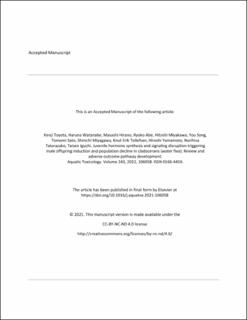| dc.contributor.author | Toyota, Kenji | |
| dc.contributor.author | Watanabe, Haruna | |
| dc.contributor.author | Hirano, Masashi | |
| dc.contributor.author | Abe, Ryoko | |
| dc.contributor.author | Miyakawa, Hitoshi | |
| dc.contributor.author | Song, You | |
| dc.contributor.author | Sato, Tomomi | |
| dc.contributor.author | Miyagawa, Shinichi | |
| dc.contributor.author | Tollefsen, Knut Erik | |
| dc.contributor.author | Yamamoto, Hiroshi | |
| dc.contributor.author | Tatarazako, Norihisa | |
| dc.contributor.author | Iguchi, Taisen | |
| dc.date.accessioned | 2022-03-24T13:13:58Z | |
| dc.date.available | 2022-03-24T13:13:58Z | |
| dc.date.created | 2022-02-21T12:37:38Z | |
| dc.date.issued | 2021 | |
| dc.identifier.citation | Aquatic Toxicology. 2021, 243 . | en_US |
| dc.identifier.issn | 0166-445X | |
| dc.identifier.uri | https://hdl.handle.net/11250/2987407 | |
| dc.description.abstract | Juvenile hormone (JH) are a family of multifunctional hormones regulating larval development, molting, metamorphosis, reproduction, and phenotypic plasticity in arthropods. Based on its importance in arthropod life histories, many insect growth regulators (IGRs) mimicking JH have been designed to control harmful insects in agriculture and aquaculture. These JH analogs (JHAs) may also pose hazards to nontarget species by causing unexpected endocrine-disrupting (ED) effects such as molting and metamorphosis defects, larval lethality, and disruption of the sexual identity. This critical review summarizes the current knowledge of the JH-mediated effects in the freshwater cladoceran crustaceans such as Daphnia species on JHA-triggered endocrine disruptive outputs to establish a systematic understanding of JHA effects. Based on the current knowledge, adverse outcome pathways (AOPs) addressing the JHA-mediated ED effects in cladoceran leading to male offspring production and subsequent population decline were developed. The weight of evidence (WoE) of AOPs was assessed according to established guidelines. The review and AOP development aim to present the current scientific understanding of the JH pathway and provide a robust reference for the development of tiered testing strategies and new risk assessment approaches for JHAs in future ecotoxicological research and regulatory processes. | |
| dc.language.iso | eng | en_US |
| dc.rights | Attribution-NonCommercial-NoDerivatives 4.0 Internasjonal | * |
| dc.rights.uri | http://creativecommons.org/licenses/by-nc-nd/4.0/deed.no | * |
| dc.title | Juvenile hormone synthesis and signaling disruption triggering male offspring induction and population decline in cladocerans (water flea): Review and adverse outcome pathway development | en_US |
| dc.type | Peer reviewed | en_US |
| dc.type | Journal article | en_US |
| dc.description.version | publishedVersion | |
| dc.description.version | acceptedVersion | |
| dc.source.pagenumber | 14 | en_US |
| dc.source.volume | 243 | en_US |
| dc.source.journal | Aquatic Toxicology | en_US |
| dc.identifier.doi | 10.1016/j.aquatox.2021.106058 | |
| dc.identifier.cristin | 2004060 | |
| dc.relation.project | Norges forskningsråd: 221455 | |
| dc.relation.project | Norges forskningsråd: 268294 | |
| dc.relation.project | Norsk institutt for vannforskning: NIVAs Computational Toxicology Program (NCTP) | |
| dc.relation.project | Norges forskningsråd: 301397 | |
| cristin.ispublished | true | |
| cristin.fulltext | original | |
| cristin.fulltext | postprint | |
| cristin.qualitycode | 2 | |

